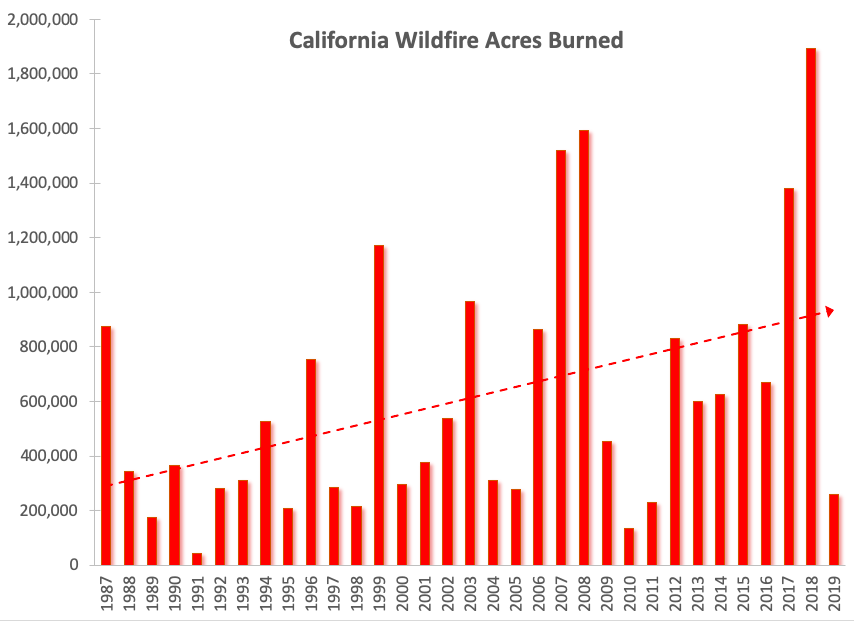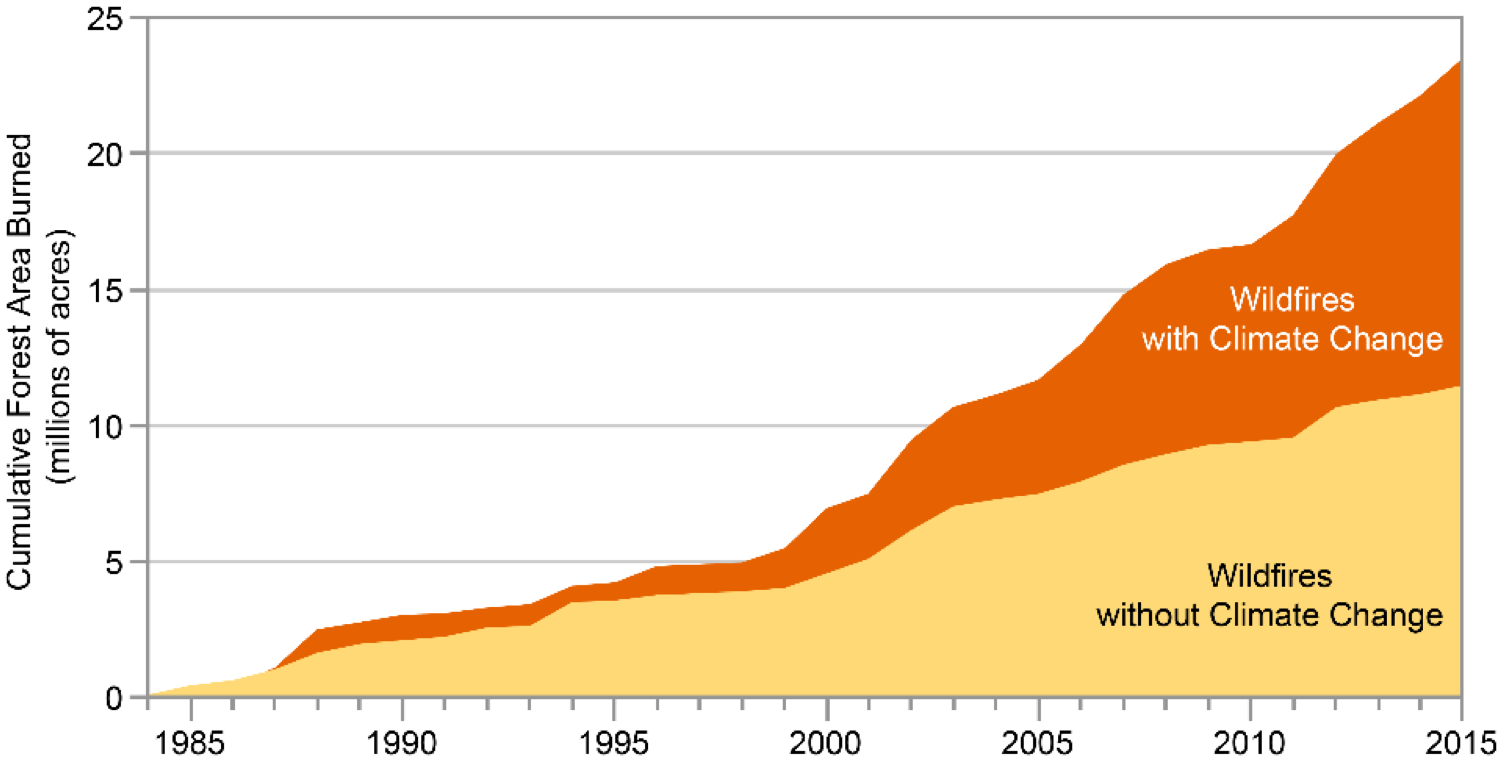
What The Science Says:
Global warming worsens wildfires by drying vegetation and soil, creating more fuel for fires to spread further and faster. In some areas like southeastern Australia and California, altered atmospheric patterns may also be creating stronger and/or more frequent high pressure systems, resulting in less precipitation and thus both dryer conditions and longer fire seasons.
Climate Myth: Wildfires are not caused by global warming
"it’s not climate change that has caused today’s [bushfire] disaster, but the criminal negligence of governments that have tried to buy green votes by locking up vast tracts of land as national parks, yet failed to spend the money needed to control ground fuel and maintain fire trails ... We can’t dial down the Earth’s temperature any more than we can lock up every teenage arsonist." [Miranda Divine, NY Post]
The clearest connection between global warming and worsening wildfires occurs through increasing evapotranspiration and the vapor-pressure deficit. In simple terms, vegetation and soil dry out, creating more fuel for fires to expand further and faster. This is particularly a problem in Mediterranean climates that are prone to drought, like in California and Australia, as climate scientist Kevin Trenberth explains in the interview below with videographer Peter Sinclair.
For example, California's record-breaking wildfire season in 2018 came at the culmination of the state's five hottest years on record (2014–2018) and a record-breaking drought (2012–2017). Australia's record-breaking bushfire season of 2019–2020 followed the continent's two hottest and driest years on record, and expanded during a record-breaking heatwave that included an average country-wide high temperature of 41.9°C (107.4°F) on 18 December 2019.
Though many factors contribute to wildfires, the reason the Australian wildfires are so much worse this year than other recent years is the combination of record drought and record heat. #AustraliaFires
— Robert Rohde (@RARohde) January 4, 2020
History of national-average temperature and precipitation since 1910. pic.twitter.com/aHh3kDFIZ7
Because of the long-term warming trend, the Fourth National Climate Assessment Report concluded,
“Climate change has led to an increase in the area burned by wildfire in the western United States. Analyses estimate that the area burned by wildfire from 1984 to 2015 was twice what would have burned had climate change not occurred. Furthermore, the area burned from 1916 to 2003 was more closely related to climate factors than to fire suppression, local fire management, or other non-climate factors.
Climate change has driven the wildfire increase, particularly by drying forests and making them more susceptible to burning.”

Acres burned by wildfires in California 1987–2019, with the linear trend shown. Data from Cal Fire.

Cumulative forest area burned in the western United States 1984–2015, and attribution to human-caused climate change. Source: Fourth National Climate Assessment.
A second, though more scientifically uncertain connection between climate and worsening wildfires involves changing atmospheric circulation patterns.
California's aforementioned record drought was exacerbated by a high-pressure ridge sitting off the Pacific coast, coined the “Ridiculously Resilient Ridge.” That ridge diverted storm systems to the north of California; the resulting period of low precipitation combined with record high temperatures to create dangerously dry wildfire conditions.
Rutgers climate scientist Jennifer Francis over the past decade has been researching the connection between changes in the Arctic and extreme weather patterns throughout the Northern Hemisphere. In recent years a growing number of climate scientists have found evidence supporting her groundbreaking research. In a 2017 paper in Nature Communications, researchers led by Ivana Cvijanovic and Ben Santer found evidence of a connection between disappearing Arctic sea ice and these high-pressure ridges in the Pacific. And in an October 2018 paper in Science Advances, scientists Michael Mann, Stefan Rahmstorf and colleagues found that depending on how human fossil fuel pollution changes in the coming years, the frequency of wavy jet stream events that often lead to high-pressure ridges off the California coast could triple by the end of the century.
The situation in Australia is again strikingly similar to that in California. Researchers have shown that global warming is expanding an atmospheric circulation pattern known as the Hadley cell. This circulation is caused by hot air at the equator rising and spreading toward the poles, where it begins to cool and descend, forming high pressure ridges. In Australia, this process creates what’s known as the subtropical ridge, which as CSIRO notes, has become more intense as a result of global warming expanding the Hadley cell circulation. A 2014 study, CSIRO’s David Post and colleagues reported that stronger high-pressure ridges have been decreasing rainfall in southeastern Australia in the autumn and winter. The lack of rainfall creates more dry fuel for fires and lengthens the bushfire season.
Based on this scientific research, the latest IPCC report found in 2014 that “fire weather is projected to increase in most of southern Australia,” with days experiencing very high and extreme fire danger increasing 5–100% by 2050. And a 2015 CSIRO report concluded, “Extreme fire weather days have increased at 24 out of 38 Australian sites from 1973-2010, due to warmer and drier conditions … [forest fire danger index] increase across southeast Australia is characterised by an extension of the fire season further into spring and autumn … partly driven by temperature increases that are attributable to climate change.”
Some are quick to point out that droughts and wildfires happen naturally, and the latter are often sparked by human activities. While that's true, it's also the case that human-caused climate change is responsible for making wildfires spread further and faster, by creating drier conditions and likely by changing atmospheric circulation patterns that result in less rainfall in some fire-prone regions like California and Australia.
This rebuttal was updated by Judith Matz in September 2021 to replace broken links. The updates are a result of our call for help published in May 2021.
 |
The Skeptical Science website by Skeptical Science is licensed under a Creative Commons Attribution 3.0 Unported License. |